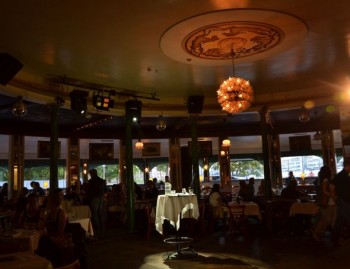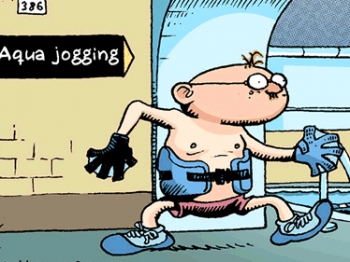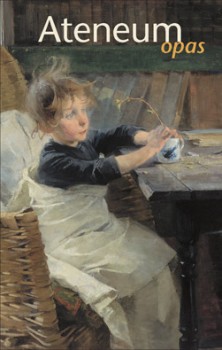Author: The Editors
Night of the Living….
5 September 2013 | In the news

Poetry in focus: Kaisaniemi Restaurant, Helsinki, 24 August. Photo: Irene Dimitropoulos
…Poets was the main event of the annual literature festival Runokuu, Poetry Moon, taking place on 24 August in a Helsinki restaurant. The theme was the sea: the invited guests were from around the Baltic Sea – as well as beyond.
The Poetry Moon festival is organised by Nuoren Voiman Liitto and Helsinki Festival, now for the ninth time, with more than 30 events taking place in the city between 22 and 28 August.
‘In four hours writers and languages kept changing fast,’ reports Irene Dimitropoulos, an intern at FILI (Finnish Literature Exchange): ‘You had to throw yourself into the rhythms and sounds of languages both familiar and strange.
‘The programme contained lots of poetry, but the short story and non-fiction were also included. The idea of the literary evenings is to meet with writers from abroad and also to support translated foreign poetry, as very little gets translated into Finnish, so translators perform with poets.
‘The stylistic and thematic variations of different generations of writers were introduced in many ways. A translation of I Am Going to Clone Myself Then Kill the Clone and Eat It [2009/2012] by the American poet Sam Pink was published in Finnish earlier this year: his style, both simple and strikingly comical, and the way he depicts everyday experiences and the violent fantasies they invoke, made the audience laugh. Crowds were also drawn to listen to the Finnish novelist Monika Fagerholm and the German poet and translator Ulrike Draesner; Fagerholm read from her book of lyrical essays on the sea, Draesner her poems dealing with womanhood and the interaction between language and body.’
Among the other poets were Peeter Sauter and Maarja Kangro from Estonia, Igor Belov and Irina Maksimova from Russia and Toh Hsien Min from Singapore.
Expat, fun
30 August 2013 | In the news

Popular Finnish aqua sports à la Pertti Jarla
Expat Finland, created by Stuart Allt – an Australian web designer living in Turku, Finland – is an information resource on the Internet. It is particularly useful for people moving to Finland, or for anyone who is interested in finding out about Finnish services and products and in living in the country in general.
If you’re looking for maps, restaurants or universities, are interested in knowing more about the language(s), culture, sports etc, take a look at the recently redesigned Expat Finland.
And what do Finns think is funny?
Among latest additions on the Expat site is a selection of comic strips by Pertti Jarla. The creator of the cartoon town Fingerpori is often impossible to translate as he constantly plays with words and their meanings (getting the joke sometimes takes a while, too).
Take also a look at the samples of Jarla’s illustrations to Zoo – eläimellinen tarina (‘Zoo – a bestial story’), a book for children by Roman Schatz and Jarla, featured in Books from Finland.
Elitist versus pop?
8 August 2013 | Letter from the Editors

An elitist of his time? A caricature of Richard Wagner by Leslie Ward, published in Vanity Fair in 1877 (caption read ‘The Music of the Future’). Picture: Wikimedia
The old phrase ‘art for art’s sake’ has begun to sound like an appeal instead of an bohemian creed, without any negative ambiguity. Please let art be created for art’s sake!
In our times of neo-liberal ideologies, the criteria for assessing art include its capacity to generate profits to creative industries, to have export value, to be of assistance to business in general. But art, in essence, serves no ideology.
Technology now allows us to be more entertained than ever before, if we so choose. Art and entertainment alike come to us by the use of various devices. What has often been called ‘elitist’ art – opera, modern music, ballet – can be enjoyed lying on the sofa in the home. Money is not an obstacle.
Art, too needs money, of course: orchestras, theatres, training of artists and artists themselves need subsidies from society. Entertainment is by nature profitable business, as it attracts and involves large paying audiences. Smaller audiences want to listen to classical music, read books and see films that are not made solely in order to bring in as much money as possible. But why should these forms of art be called ‘elitist’? More…
Reindeer yoga?
15 July 2013 | This 'n' that

Human yoga wheel. Photo: Wikimedia
While Finnish politicians, just back at Parliament after their summer break, twiddle their thumbs in frustration as the nation faces darkening prospects for economic growth, Finland is being admired across the pond.
The Atlantic magazine took a long look at ‘the secrets of Finland’s success with schools, moms, kids – and everything’ (July 2013).
Olga Khazan reports: Finns enjoy long vacations, better school scores, unemployment insurance, paid parental leaves, cheap child care, education and medical services, and low infant mortality rates.
‘All of this adds up to the stress equivalent of living in what is essentially a vast, reindeer-fur-lined yoga studio.’
Whoa! Are we that happy in Finland? More…
Books from Helsinki
30 June 2013 | This 'n' that

Helsinki: view it from different angles! Photo: Leena Lahti
Helsinki is relatively young city, Finnish literature even younger.
Flushed with a huge wave of migration at the beginning of the 20th century, the capital and its people went through the dramatic times of gaining independence and the Civil War (1917–18). The capital – since 1812 – and the life experiences of its inhabitants have been plentifully featured in Finnish fiction.
In his doctoral dissertation, Lieven Ameel has concentrated on a period of Finnish literary history. His Moved by the City: Experiences of Helsinki in Finnish Prose Fiction 1889–1941 (2013, Department of Finnish, Finno-Ugrian and Scandinavian Studies, University of Helsinki) examines more than sixty novels, collections of short stories and individual short stories portraying the city: how do the characters experience this urban public space? (Popular – crime fiction, for example – and children’s literature are excluded.) More…
New library for Helsinki
20 June 2013 | In the news

The new Helsinki library: Käännös by ALA Architects Ltd
The city of Helsinki will have a new Central Library in the near future: an architectural competition for a new building was completed in June. The winner, chosen out of 554 entries, foreign and Finnish, is entitled Käännös (‘Turn’ – or ‘Translation’), entered by the Finnish ALA Architects Ltd (architects Juho Grönholm, Antti Nousjoki, Janne Teräsvirta, Samuli Woolston). The entry was also one of the favourites with the public in an earlier stage of the competition.
The jury’s decision was unanimous: in their opinion, Käännös is ‘impressive’ and ‘casually generous’; it fits into the urban structure as an feasible, usable and ecological construction. The site could not be more central: close to the citys’ railway station, it faces the House of Parliament, next to the Museum of Contemporary Art Kiasma and the new Music Centre (opened 2011): literary art and literature will join the other art forms.
Winging it
6 June 2013 | This 'n' that

From Finland to Africa: Ilmari takes off in 2012. Photo: Juhani Koivu
Ilmari is back!
Last October we brought you the story of a winged traveller who left his home in southern Finland for Africa. Ilmari is a nine-year old osprey who spent his winter in Cameroon; as he and his family are fish-eaters, they have to foresake their frozen homeland for about five months of the year.
It’s a long way to Cameroon, around 6,500 kilometres, and the return trip is a dangerous one. But Ilmari made it: his satellite transmitter reported that he returned to his native landscape on 21 April, after flying 7,351 kilometres, which took him 23 days – an average of 320 kilometres per day. He took a couple of days off on Crete and in Serbia.
Now satellite transmitters and live cameras reveal all the intimate secrets of birds of prey (and bears, hibernating in their lairs). On this British site osprey Lizzie babysits as her chicks flap their tiny wings in early June.
Now it’s time for Ilmari to concentrate on fishing, hopefully in order to feed his offspring – until October, when he will take to the skies again.
Art online
23 May 2013 | In the news

Helene Schjerfbeck’s The convalescent (1888) on the cover of the guidebook of the Ateneum Art Museum
Attention lovers of Finnish art: the Ateneum Art Museum in Helsinki has joined the international Google Art Project (begun in 2011), with 260 participating art institutes and more than 40,000 works of art as high-resolution images.
The website also includes information on the paintings. Among the 55 images from Ateneum on show now are many of the great works of the golden period of Finnish art (1880–1910), including Hugo Simberg’s darkly cute The Garden of Death, Albert Edelfelt’s heartbreakingly beautiful Conveying a Child’s Coffin, Akseli Gallen-Kallela’s classic portrayal of grief, Lemminkäinen’s mother, and – a personal favourite here at the Books from Finland office – Magnus von Wright’s evocative Annankatu Street on a Cold Winter’s Morning.
The Ateneum has few foreign works of art; in the Google Art collection now there are one Rodin, a Modigliani, a van Gogh and two Gauguins.
Favourites in April: what Finland read
8 May 2013 | In the news
 In April number one on the list of best-selling Finnish fiction titles, compiled by the Finnish Booksellers’ Association, was Seppo Jokinen’s crime novel Vihan sukua (‘Akin to hate’, Crime Time). The winner of the 2012 Finlandia Prize for Fiction, Ulla-Lena Lundberg’s Is (‘Ice’), still holds second place.
In April number one on the list of best-selling Finnish fiction titles, compiled by the Finnish Booksellers’ Association, was Seppo Jokinen’s crime novel Vihan sukua (‘Akin to hate’, Crime Time). The winner of the 2012 Finlandia Prize for Fiction, Ulla-Lena Lundberg’s Is (‘Ice’), still holds second place.
Pertti Jarla seems to have secured his place on the best-seller list: his latest serial comics book about the inhabitants of the city of Fingerpori (‘Fingerborg’, Arktinen Banaani), Lääkärileikit (‘Playing doctors’) was number three and the album Fingerpori 6 number four.
Paulo Coelho ruled the translated fiction list with his Manuscript Found In Accra. There are more people who find his books fascinating than there are people who don’t.
At the top of the non-fiction list remained, for the third time now, Kaiken käsikirja (‘Handbook of everything’, Ursa) by astronomer and popular writer Esko Valtaoja; as it doesn’t provide the reader with instructions for cooking, perhaps buyers went on to buy number two, Safkaa: parempaa arkiruokaa (‘Grub: better food for weekdays’, Otava) by Alexander and Hanna Gullichsen. Last year’s big social-media hit hails from this book: avocado pasta (chili, lime, basil, garlic, spaghetti, parmesan).
Safka, incidentally, comes from the Russian word zavtrak, breakfast. (The title of the book could also have been Sapuskaa…, the word also means ‘grub’, from the Russian word zakuska, hors d’oeuvres.)
Designbites
26 April 2013 | This 'n' that
 Hey, design hipsters, wherever you are – after the super-serious focus brought about by Helsinki’s year as World Design Capital 2012, here’s a way to blow off steam.
Hey, design hipsters, wherever you are – after the super-serious focus brought about by Helsinki’s year as World Design Capital 2012, here’s a way to blow off steam.
Written by the comic-strip artist, illustrator and designer Kasper Strömman (born 1974), The Kasper Stromman Illustrated Design Encyclopedia (HuudaHuuda, 2013) consists of a series of post-ironic sound-bites on Finnish material culture.
Strömman was voted Graphic Designer of 2013 in Finland by Grafia (Association of Visual Communication Designers), by a jury that considered him to be a ‘catalyst, challenger and the standup comedian of graphic design’.
His book really is encyclopaedic, with entries ranging from the usual suspects (Artek, Arabia, Iittala) through the iconoclastic (in purist design terms, anyway: Angry Birds, the heteka sofa bed, Nokia gumboots and mobile phones) and the everyday (hapankorppu crispbread, vihreä kuula sweets, the Anttila mail-order catalogue and store) to the just plain wacky (the Aqua Tube disposable toilet roll, the Konrad ReijoWaara bridge, the Superlon mattress).
There are also fun sections on how to make your own design classics – for example, a pair of original orange Fiskars scissors (just use some paint) or Harri Koskinen’s glass block lamp – and outings to less-than-fashionable destinations (in eastern Helsinki) such as the Puhos shopping centre or the Itä-Pasila housing estate.
And so on. You can get a taste of what to expect at Kasper Strömman’s design blog in English (sadly discontinued, although it remains online. He’s started a new blog, although only in Finnish, entitled Kasper Diem…).
So far, so good; we like the idea, and it’s hard to think of another source that succeeds so well in bringing together every material thing we think of as Finnish. The problem is that it’s all delivered in faintly annoying one-liners – Kalevala Koru makes ‘jewellery based on bronze age findings, usually bought for you by your parents’; the Jugend style of architecture ‘should not be confused with “Hitler Jugend”’; Lapponia, Lapland in Latin, ‘useful to know if you were planning a ski trip in the Middle Ages’ – quite funny at first, but in the end they begin to get on your nerves. It’s like a diet of street food that never quite adds up to a meal.
The book’s foreword claims it to be ‘unique in the sense that it was put together with a minimum amount of research’ – no designers’ names or information-based facts. There’s an advantage here – it means that Strömman has felt free to include, among his opinions, plenty of oral and hearsay information, essential in dealing with everyday objects and their meanings.
But it also means that, too often, the author has let himself off the hook with a gag or a quip when staying with the subject would have been really rewarding. It’s a bit too much like material culture with attention deficit disorder. (It’s also hard to see who the book is really directed at – many of the jokes are so ‘in’ that it’s only those who are already in the know who will appreciate them.)
So hey, guys (Strömman refers to himself in the plural, so we will too), how about a challenge? Why not take yourselves seriously, and write the full-out version?
Books and roses
23 April 2013 | In the news
 The tradition of the international Day of the Book and the Rose derives from 1920s Barcelona, where the tradition was for men to give women roses while women gave men books.
The tradition of the international Day of the Book and the Rose derives from 1920s Barcelona, where the tradition was for men to give women roses while women gave men books.
23 April is the day – and it is (possibly) also Shakespeare’s birthday. In 1995 UNESCO proclaimed it is the World Book and Copyright Day.
(Actually, we’ve always thought the idea of what is exchanged is rather silly. As women, we would much rather be given a a book than a withering cut flower. On the other hand though, a rose is a safe bet….)
Last year, the Finnish booksellers decided to celebrate the occasion by publishing a new novel which was given for free to all customers who made a purchase worth €10. This was the only way to get hold of a copy; the print run was 3,000 copies. The author was Tuomas Kyrö, the novel, Miniä (‘Daughter-in-law’).
This year the print run is more than tenfold, and the author is Jari Tervo. His novel Jarrusukka (‘Slipper sock’) tells the story of a teacher, working in an immigrant neighbourhood, who finds out it’s not possible to lease a baby in a short term.
Writers breaking walls
19 April 2013 | In the news

Meeting place for writers: Messilä Manor, Lahti. Photo: LIWRE
The theme of the next biannual International Writers’ Reunion (LIWRE), which takes place in Lahti, southern Finland, will be ‘Breaking walls’.
‘The writer always examines his own limits and boundaries, creates a new version not only of reality but of himself. He addresses, touches and jolts, awakens his readers to see alternative worlds and accept otherness. But is the writer an engine of change, or the eternal stranger?
‘Problems demand answers, answers demand questions. If attitudes harden, arms talk, and everyone erects a wall around himself, where is literature in the equation? Is the highest wall right there inside the writer? Or is literature itself a protecting wall? What happens, when walls break down?’
The 26th Reunion will take place at the Messilä Manor in Lahti 16–18 June. Among the participants – 24 foreign writers so far – will be the Havanna-born Abilio Estévez, Davide Enian from Sicily, Anna Szabo from Hungary and the Dutch-Finnish Kira Wuck.
The chairperson, author and researcher Virpi Hämeen-Anttila, who together with Jarmo Papinniemi (who died last autumn) has chaired the discussions at three Reunions, will now be partnered by writer and journalist Joni Pyysalo.
Fatherlands, mother tongues?
12 April 2013 | Letter from the Editors

Patron saint of translators: St Jerome (d. 420), translating the Bible into Latin. Pieter Coecke van Aelst, ca 1530. Walters Art Museum, Baltimore. Photo: Wikipedia
Finnish is spoken mostly in Finland, whereas English is spoken everywhere. A Finnish writer, however, doesn’t necessarily write in any of Finland’s three national languages (Finnish, Swedish and Sámi).
What is a Finnish book, then – and (something of particular interest to us here at the Books from Finland offices) is it the same thing as a book from Finland? Let’s take a look at a few examples of how languages – and fatherlands – fluctuate.
Hannu Rajaniemi has Finnish as his mother tongue, but has written two sci-fi novels in English, which were published in England. A Doctor in Physics specialising in string theory, Rajaniemi works at Edinburgh University and lives in Scotland. His books have been translated into Finnish; the second one, The Fractal Prince / Fraktaaliruhtinas (2012) was in March 2013 on fifth place on the list of the best-selling books in Finland. (Here, a sample from his first book, The Quantum Thief, 2011, Gollancz.)
Emmi Itäranta, a Finn who lives in Canterbury, England, published her first novel, Teemestarin tarina (‘The tea master’s book’, Teos, 2012), in Finland. She rewrote it in English and it will be published as Memory of Water in England, the United States and Australia (HarperCollins Voyager) in 2014. Translations into six other languages will follow. More…
Love me tender… in Latin
12 April 2013 | This 'n' that

Latin Bible, 1407. Malmesbury Abbey, Wiltshire, UK. Photo: Arpingstone, Wikipedia
Nuntii Latini, conspectus rerum internationalium hebdomadalis, est programma Radiophoniae Finnicae Generalis in terrarum orbe unicum.
Nuntii Latini is a five-minute radio programme broadcast every Friday by the Finnish Broadcasting Company, YLE. It is the only regular news programme in Latin in the world, and has been on the air since 1989. (Not even Vatican Radio broadcasts news.)
Professor Tuomo Pekkanen from Jyväskylä University and Reijo Pitkäranta are the founding fathers of the programme, and they are helped by some other friends of Latin.
In a report on 8 April The New York Times wrote that even Elvis Presley has inspired the friends of the dead language: Jukka Ammondt, a Finnish university lecturer in English and German, began singing Elvis songs in Latin a couple of decades ago, and occasionally still does. Love Me Tender: Tenere Me Ama.
John Tagliabue describes in his article how Leah Whittington, an English professor at Harvard, ‘catches the news bulletins on her iPod while strolling to classes.’ Whittington says: ‘I’m often struck when I’m listening how well structured they are, how idiomatic, how precise the vocabulary is.’
The editors don’t invent new words, they look for new expressions using existing Latin vocabulary. A golf course, for example, is campus pilamallei.
Coming up…
11 April 2013 | This 'n' that

Illustration: Mikko Metsähonkala
‘Just before the meeting Ludwig chickened out. In the ad he had bragged that he was a “sporty male with a sense of humour”. Would Patsy accept his illiteracy, brutal table manners and cruelty towards the peasants?’
One picture, few words: Mikko Metsähonkala’s artwork creates a moment in a universe – recognisable or completely strange – providing it with a laconic textual subtext. We feature some of his stories published in Toisaalta / (P)å andra sidan / In Other Wor(l)ds.
